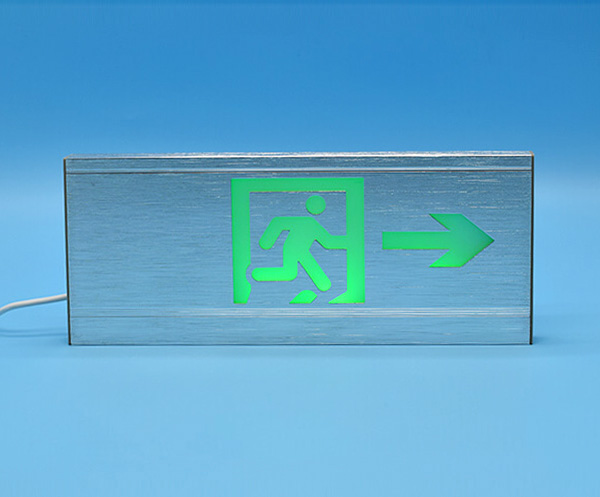Emergency exit lighting plays a crucial role in ensuring the safety and well-being of individuals during emergencies, such as fires or power outages, by providing clear and visible guidance to designated exit points. Proper installation of emergency exit lighting is essential to ensure its effectiveness in emergency situations. In this article, we will discuss important guidelines for installing emergency exit lighting.

Emergency Exit Lighting GS-ES16
Installing emergency lights is critical to the safety of any building. To ensure that the lights are properly installed, it is important to determine the type of lights needed and their best mounting locations. The installation process must comply with safety codes and regulatory requirements, such as UL924 Emergency Lighting and Exit Signs or NFPA 101, to ensure optimal protection for all building occupants. After the lights are installed, they must be tested to ensure that they are functioning properly.
Familiarize Yourself with Building Codes and Regulations:
Before beginning the installation process, it is crucial to familiarize yourself with the local building codes and regulations pertaining to emergency exit lighting. These codes provide specific guidelines on the number, type, placement, and illumination requirements for exit signs and emergency lighting systems. Compliance with these regulations is essential for the safety and legal compliance of your building.
Conduct a Thorough Site Assessment:
Before installing emergency exit lighting, conduct a thorough site assessment to determine the appropriate locations for exit signs and emergency lighting fixtures. Take into consideration factors such as the layout of the building, the number of floors, the size of rooms, stairwells, corridors, and any specific hazard areas. Identify primary escape routes and ensure that exit signs and lighting are placed in strategic positions to provide clear and unobstructed paths to safety.
Choose the Right Type of Emergency Exit Lighting:
There are different types of emergency exit lighting systems available, including self-contained units, central battery systems, and generator-powered systems. Each type has its own advantages and considerations. Select the type that best suits the needs of your building and ensures compliance with local regulations. Consider factors such as battery life, maintenance requirements, and system reliability when making your selection.
Ensure Proper Placement of Exit Signs:
Exit signs should be placed in locations that are highly visible and easily identifiable, even in low light or smoky conditions. The signs should be positioned at a height of at least 7 feet above the floor and placed directly above or adjacent to each exit door. Additionally, signs should be placed along exit access corridors and at all points where the direction of travel changes.
Determine Adequate Illumination Levels:
Emergency exit lighting should provide sufficient illumination to clearly see the exit route and any obstacles along the way. The minimum required illumination levels are typically specified in local building codes and regulations. It is important to ensure that the chosen emergency exit lighting system meets or exceeds these requirements.
Consider Emergency Lighting for Stairwells and Hazardous Areas:
In addition to exit signs, emergency lighting should be provided in stairwells, corridors, and other areas that may pose potential hazards during an emergency. Stairwell lighting should be installed in a way that ensures uniform illumination on each step, eliminating shadows and potential tripping hazards. Hazardous areas, such as areas with machinery or flammable materials, should be equipped with appropriate emergency lighting to facilitate safe evacuation.
Test and Maintain the Emergency Exit Lighting System:
Once the installation is complete, regular testing and maintenance of the emergency exit lighting system are vital to ensure its reliability. Conduct routine inspections, battery tests, and lamp replacements as per the manufacturer's recommendations. Keep a log of all maintenance activities for documentation purposes and to demonstrate compliance during inspections.
In conclusion, proper installation of emergency exit lighting is crucial for the safety of building occupants during emergencies. By following the guidelines mentioned above and adhering to local building codes and regulations, you can ensure that your emergency exit lighting system is effective, reliable, and in compliance with the required standards. Remember to conduct regular testing and maintenance to keep the system in optimal working condition. For more information, please contact us. We will provide professional answers.

 Ni-MH Battery C4700mAh 3.6V
Ni-MH Battery C4700mAh 3.6V Nickel Cadmium Nicd Battery Pack SC1800mAh 3.6V
Nickel Cadmium Nicd Battery Pack SC1800mAh 3.6V Ni-Cd Battery Pack D4000mAh 3.6V
Ni-Cd Battery Pack D4000mAh 3.6V Ni-Cd Battery Pack C2500mAh 3.6V
Ni-Cd Battery Pack C2500mAh 3.6V NICAD Battery Pack AA900mAh 3.6V
NICAD Battery Pack AA900mAh 3.6V LiFePO4 IFR18650 1600mAh 3.2V
LiFePO4 IFR18650 1600mAh 3.2V LiFePO4 IFR18650 1600mAh 6.4V
LiFePO4 IFR18650 1600mAh 6.4V Ni-MH Battery C4000mAh 3.6V
Ni-MH Battery C4000mAh 3.6V E-bike Battery 48V 10Ah JL-1
E-bike Battery 48V 10Ah JL-1 E-bike battery 48V 10Ah Qing Tian
E-bike battery 48V 10Ah Qing Tian